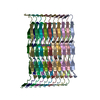+Search query
-Structure paper
| Title | The Positively Charged Cluster in the N-terminal Disordered Region may Affect Prion Protein Misfolding: Cryo-EM Structure of Hamster PrP(23-144) Fibrils. |
|---|---|
| Journal, issue, pages | J Mol Biol, Vol. 436, Issue 11, Page 168576, Year 2024 |
| Publish date | Apr 18, 2024 |
 Authors Authors | Chih-Hsuan Lee / Jing-Ee Saw / Eric H-L Chen / Chun-Hsiung Wang / Takayuki Uchihashi / Rita P-Y Chen /   |
| PubMed Abstract | Prions, the misfolding form of prion proteins, are contagious proteinaceous macromolecules. Recent studies have shown that infectious prion fibrils formed in the brain and non-infectious fibrils ...Prions, the misfolding form of prion proteins, are contagious proteinaceous macromolecules. Recent studies have shown that infectious prion fibrils formed in the brain and non-infectious fibrils formed from recombinant prion protein in a partially denaturing condition have distinct structures. The amyloid core of the in vitro-prepared non-infectious fibrils starts at about residue 160, while that of infectious prion fibrils formed in the brain involves a longer sequence (residues ∼90-230) of structural conversion. The C-terminal truncated prion protein PrP(23-144) can form infectious fibrils under certain conditions and cause disease in animals. In this study, we used cryogenic electron microscopy (cryo-EM) to resolve the structure of hamster sHaPrP(23-144) fibrils prepared at pH 3.7. This 2.88 Å cryo-EM structure has an amyloid core covering residues 94-144. It comprises two protofilaments, each containing five β-strands arranged as a long hairpin plus an N-terminal β-strand. This N-terminal β-strand resides in a positively charged cluster region (named PCC2; sequence 96-111), which interacts with the turn region of the opposite protofilaments' hairpin to stabilize the fibril structure. Interestingly, this sHaPrP(23-144) fibril structure differs from a recently reported structure formed by the human or mouse counterpart at pH 6.5. Moreover, sHaPrP(23-144) fibrils have many structural features in common with infectious prions. Whether this structure is infectious remains to be determined. More importantly, the sHaPrP(23-144) structure is different from the sHaPrP(108-144) fibrils prepared in the same fibrillization buffer, indicating that the N-terminal disordered region, possibly the positively charged cluster, influences the misfolding pathway of the prion protein. |
 External links External links |  J Mol Biol / J Mol Biol /  PubMed:38641239 PubMed:38641239 |
| Methods | EM (helical sym.) |
| Resolution | 2.88 Å |
| Structure data | EMDB-37963, PDB-8wzx: |
| Source |
|
 Keywords Keywords | PROTEIN FIBRIL /  prion / 23-144 / prion / 23-144 /  hamster / PrP hamster / PrP |
 Movie
Movie Controller
Controller Structure viewers
Structure viewers About Yorodumi Papers
About Yorodumi Papers






